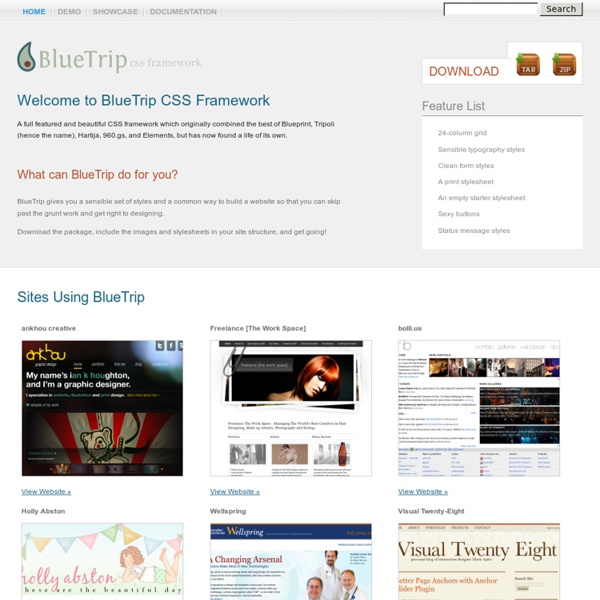



ntent with Style - A CSS Framework In my Modular CSS article I documented the possibility of breaking down stylesheets into components that could be reused across projects. All well and good. The next logical step is to extend this to become a CSS framework, allowing rapid development of sites with pre-written and tested components. Who is this for? If you've been creating sites with CSS for a while you may be getting frustrated with having to recreate and retest basic layouts on a regular basis. How many layouts are there? Well, loads but the majority of them fall into rough groups. Vertical navigation with one content column Vertical navigation with two columns of content Horizontal navigation with one content column Horizontal navigation with 2 columns of content Horizontal navigation with local navigation and one column of content Horizontal navigation with local navigation and 2 columns of content These 6 cover most of the blogs out there and most of the corporate sites as well. What are the common elements? <!
Selectivizr - CSS3 pseudo-class and attribute selectors for IE 6-8 WebApp.Net SenCSs - the sensible standards CSS baseline CSS3 PIE: CSS3 decorations for IE Web Design for Developers 960 Grid System Ultimate CSS Gradient Generator - ColorZilla.com /* Permalink - use to edit and share this gradient: */ background: #1e5799; /* Old browsers */ background: -moz-linear-gradient(top, #1e5799 0%, #2989d8 50%, #207cca 51%, #7db9e8 100%); /* FF3.6-15 */ background: -webkit-linear-gradient(top, #1e5799 0%,#2989d8 50%,#207cca 51%,#7db9e8 100%); /* Chrome10-25,Safari5.1-6 */ background: linear-gradient(to bottom, #1e5799 0%,#2989d8 50%,#207cca 51%,#7db9e8 100%); /* W3C, IE10+, FF16+, Chrome26+, Opera12+, Safari7+ */ filter: progid:DXImageTransform.Microsoft.gradient( startColorstr='#1e5799', endColorstr='#7db9e8',GradientType=0 ); /* IE6-9 */ /* Permalink - use to edit and share this gradient: */ background: #1e5799; /* Old browsers */ background: -moz-linear-gradient(top, #1e5799 0%, #2989d8 50%, #207cca 51%, #7db9e8 100%); /* FF3.6-15 */
CSS Tip: Get Any Font You Want CSS Tip: Get Any Font You Want by Larisa Thomason, Senior Web Analyst, NetMechanic, Inc. Have your heart set on using a particular font on your site? If your page requires an unusual font, you can embed it with a Cascading Style Sheet (CSS). Why Use Embedded Fonts? Because a font is an operating system resource, not a browser resource. From a page designer's perspective, this is a big weakness. That's where embedded fonts come in: with them, you don't have to worry about browsers defaulting to a more common font. Apply the font by name to your page using either the <FONT FACE> tag or the FONT-FAMILY property in CSS1. Embedding a font is a 3-step process: 1. Finding fonts is easy. Do some research first though: some designers don't allow their fonts to be embedded. 2. You have to use a third-party application that creates an embedded font file using the font you installed locally on your hard drive. Recently though, Netscape updated its method to support Explorer browsers. 3.
Fluid 960 Grid System | 16-column Grid Article Heading Subheading Lorem ipsum dolor sit amet, consectetuer adipiscing elit, sed diam nonummy nibh euismod tincidunt ut laoreet dolore magna aliquam erat volutpat. Ut wisi enim ad minim veniam, quis nostrud exerci tation ullamcorper suscipit lobortis nisl ut aliquip ex ea commodo consequat. Visit site. Heading 3 Heading 4 Heading 5 Duis autem vel eum iriure dolor in hendrerit in vulputate velit esse molestie consequat, vel illum dolore eu feugiat nulla facilisis at vero eros et accumsan et iusto odio dignissim qui blandit praesent luptatum zzril delenit augue duis dolore te feugait nulla facilisi. Heading 6 Epsum factorial non deposit quid pro quo hic escorol.